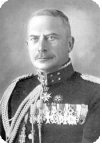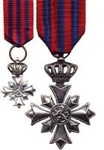History
The early years
The TMPT was organized for the first time in 1936. The field of participants then consisted of the respectable number of 12 participants, 5 professional officers and 7 reserve officers. The performance march involved covering 40 kilometers on horseback, 25 kilometers on foot and 60 kilometers by bicycle for two consecutive days per day, within 17 hours. This involved wearing the full field uniform with gas mask. The gas mask had to be placed for half an hour per section. Furthermore, after the 17 hours on both days one had to complete a shooting test.
The first general leader of the T.M.P.T. was the reserve first lieutenant in the 5th Regiment Field Artillery A.R. Klein. At that time, the background of the TMPT was, "High demands will be placed on the commanders of troops in the field in wartime in terms of physical training and endurance."

The first certificates for obtaining the TMPT were issued by C-4th div Maj Gen J.J.G. Baron van Voorst tot Voorst, later Field Army Commander in the May days of 1940.
As characteristics of the TMPT was noted:
- Pleasant camaraderie with joint participation of both professional and reserve officers.
- The 3 parts (riding, walking, cycling) are not tough by themselves, but the combination places very high demands on the participants. Without serious training, except perhaps for a few, the trip is not to be accomplished.
In 1937 and 1938 the number of participants doubled each time and the third TMPT in 1938 was visited by HRH Prince Bernhard.
At the 4th TMPT in 1939, Prince Bernhard was one of 71 participants. Because of his participation, there was much interest from authorities, press and public. "The public's interest in the Prince was so great that the Police occasionally had to intervene to keep overly enthusiastic spectators at bay".
At this TMPT there was an important change. Instead of 40 km on horseback, one was allowed to ride 250 km on a motorcycle. However, the achievement had to be completed within 17 hours.
In 1940 and 1941, the TMPT was organized in our former Dutch East Indies, held under the auspices of the then still existing department of the AVNRO. Various circumstances and difficulties led to the fact, that after 1945 this important performance tour could not be organized until now (1955).
On May 25 and 26, 1955, the 7th TMPT is organized in Amersfoort. In connection with the changed circumstances, the horse was definitely replaced by 125 km car or motorcycle riding along beaten roads.On the first day a shooting test must be completed and on the second day an obstacle course.
Under ideal weather conditions, 159 participants started the 8th TMPT on June 20, 1956. Once again the Bernhardkazerne in Amersfoort was center of activities.
Professional officers and reserve officers in actual service receive vehicles provided by the government. Others had to rely on their own transportation.
THE TMPT at the end of the 20th century
The horse gave way to the automobile, the requirements were modified, but the level of performance was maintained. Participation grew steadily, reaching a maximum of about 600 participants in the late 1980s. The requirements that had to be met were:
1. Completing a map-reading task by passenger car over a distance of 140 km (to be counted from starting point to finishing point) in teams of two men.
a. The map-reading task is performed by crews consisting of 1 driver and 1 map-reader.
b. The result of the map reading assignment will be attributed exclusively to the map reader.
c. The crew will complete both card reading assignments (first and second day) in such a way that the driver on the first day is the card reader on the second day and vice versa.
2. Covering a 25 kilometer course on foot (for officers aged 45-60 this will be 20 km., officers over 60 15 km.).
3. Traveling individually by bicycle a course of 60 kilometers (for officers aged 45-60 this will be 50 km., officers over 60 40 km.).
4. Taking a shooting test.
a. This involves shooting with a pistol (Glock-17, caliber 9 mm) in a rapid-fire series of 4 shots in 10 seconds.
b. At the start of the 10 seconds, the pistol may already be aimed at the target. The starting signal is a whistle, after 8 seconds a 2 second whistle sounds. At this point, shots may still be fired. Any shot fired thereafter will be deducted from the valid hits.
c. The stance is standing, two-handed.
d. The target is the Pistol Target (trunk disk) at a distance of 25 meters.
e. Minimum requirement is 3 hits. The shooter has two chances of 10 seconds each.
In 1993, Prince Pieter Christiaan achieved the TMPT Cross.
The policy of the TMPT committee in those years was:
"The TMPT is a unique event, combining a military-sports performance with a gathering in an atmosphere of camaraderie."
Until the late 1970s/early 1980s, the map-reading task was performed alone. However, for reasons of road safety, this was abandoned.
In 1998, the 50th TMPT was held, which did not lack the "horses of yesteryear" either.
As of 2003 - the 55th TMPT - the TMPT has been opened to all military personnel of the armed forces and its contents have been changed considerably in order to meet, especially in a physical sense, the requirements, which are set by the Ministry of Defense for the four distinguishable sports medals. Since 2003, the LO/Sport organization of the Royal Army has been represented on the TMPT committee.

